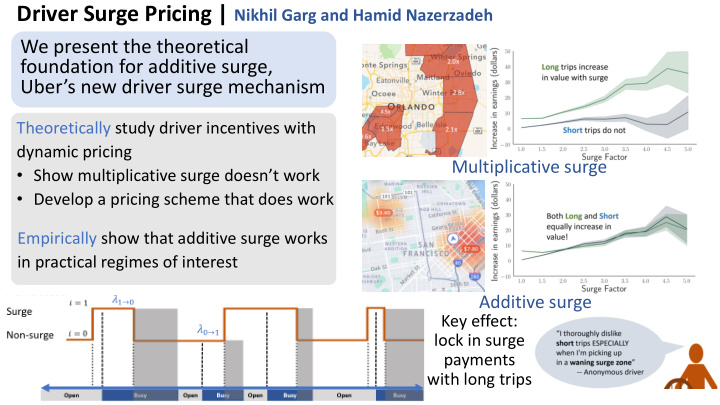



Driver Surge Pricing | Nikhil Garg and Hamid Nazerzadeh We present the theoretical foundation for additive surge, Uber’s new driver surge mechanism Theoretically study driver incentives with dynamic pricing Multiplicative surge • Show multiplicative surge doesn’t work • Develop a pricing scheme that does work Empirically show that additive surge works in practical regimes of interest Additive surge Key effect: lock in surge payments with long trips
Theoretical results Ignoring demand dynamics, naïve old pricing model works well. Theorem : In the static model, Proportional pricing 𝑥 𝜐 = 𝑛𝜐 is incentive compatible. With demand dynamics, it doesn’t. Theorem: Proportional pricing may not be incentive compatible If payout during surge is proportional, 𝑥 1 (𝜐) = 𝑛 1 𝜐 then 𝜏 1 = 𝑈 1 , ∞ , i.e., rejecting short trips, is optimal With demand dynamics, additive surge approximately works. 𝑄 0 𝑄 1 ∈ [𝐷, 1] , we have IC prices of the form: Theorem: For 𝜇 𝑗→𝑘 1 − 𝑓 − 𝜇 𝑗→𝑘 +𝜇 𝑘→𝑗 𝜐 𝑥 𝑗 𝜐 = 𝑛 𝑗 𝜐 + 𝑨 𝑗 𝜇 𝑗→𝑘 +𝜇 𝑘→𝑗
𝑄 0 𝑄 1 ∈ [𝐷, 1] , we have IC prices of the form: Theorem: For 𝜇 𝑗→𝑘 1 − 𝑓 − 𝜇 𝑗→𝑘 +𝜇 𝑘→𝑗 𝜐 𝑥 𝑗 𝜐 = 𝑛 𝑗 𝜐 + 𝑨 𝑗 𝜇 𝑗→𝑘 +𝜇 𝑘→𝑗 with 𝑛 0 , 𝑛 1 , 𝑨 1 ≥ 0. Probability that a trip of length 𝜐 If surge is too valuable compared that starts in state 𝑗 ends in state 𝑘 to non-surge on average, then cannot build fully IC prices Continuation value: compensate drivers for taking them out of surge We have 𝑛 𝑗 , 𝑨 𝑗 , 𝐷 in closed form in terms of the model parameters
Empirical goal: Estimate value of a request How does accepting a given trip request change a driver’s expected earnings over the next 90 minutes? Receives + Observe actual 90 minutes driver earnings accepts trip 𝜐 later Open Busy Does not Use nearby driver accept request as counter-factual Open Find a nearby driver match by checking trips that were recently completed with a nearby destination
Recommend
More recommend